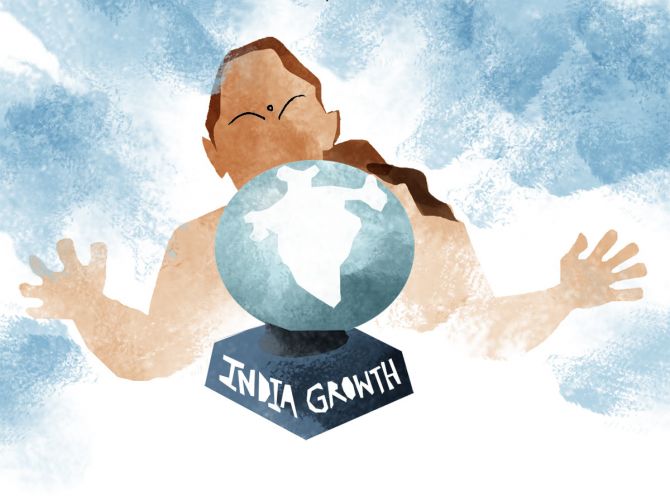The external environment has worsened further.

While the Finnish economy entered into a recession, Swedish economic growth also dipped.
The Finnish gross domestic product (GDP) dropped 0.6 per cent in October-December, 2022.
It was the second quarter of negative growth, which is a technical definition of recession.
Swedish GDP fell by 0.2 per cent in the fourth quarter of 2022, compared to the same period a year earlier. However, it was still not in recession.
While Finland and Sweden don't have much trade with India, it may have repercussions for the European Union.
The European Central Bank has already hinted that it may raise interest rates further to cool inflation.
Elsewhere, the UK economy narrowly avoided recession after its GDP was flat in the fourth quarter of 2022.
The Chinese authorities were conservative when they pegged 2023 economic growth at five per cent, one of its lowest targets in decades.
However, the target was more than China’s economic growth of three per cent in 2022.
The growth in 2022 was lower than the target of about 5.5 per cent as Covid restrictions, a property market lull, government crackdowns on private enterprise, and the United States-China trade war pulled down growth.
There are all possibilities that the Federal Reserve will raise interest rates further to tame inflation.
Core personal consumption expenditure deflator – a measure of the spending on goods and services (excluding food and energy) by people of the United States – rose by 0.6 per cent in January 2023 against an estimated 0.4 per cent on a month-on-month (MoM) basis.
There has also been an upshot in personal spending by 1.8 per cent on MoM basis against an estimated 1.4 per cent in January 2023.
The inflation expectation of the University of Michigan also remained elevated.
The new home sales data, too, pointed towards revival with a 7.2 per cent MoM increase against an estimated 0.7 per cent increase in February this year.
The markets are expecting the US Federal Reserve to hike rates by 25-50 basis points (bps) in its Federal Open Market Committee (FOMC) meeting to be held on March 21-22.
The US, European Union, China, and the UK together accounted for around 40 per cent of the total exports from India during the first 10 months of the current financial year.
India may have to hugely rely on domestic consumption to drive growth as the external environment as cited above is facing a slowdown.
In this connection, the crucial issue is whether a 6-6.8 per cent economic growth rate with 6.5 per cent as baseline scenario for 2023-24 as projected by the economic survey will materialise or not.
Ranen Banerjee, the government sector leader at PwC India, said the projected growth rate will be at risk if the external environment continues to be weak or further worsen and the growth rate is likely to be towards the lower end of the projected range or even lower.
"There are too many uncertainties at play with new risk terms being coined every day like the perma crisis and polycrisis.
"It reflects the increasingly uncertain world we are in and this makes growth projections even in the near term very uncertain," he said.
A crisis refers to a temporary period of downturn, but the term permacrisis denotes a long and permanent period of crisis as a result of different factors that come together or follow each other.
The term was coined around 2022 when, after the Covid-induced crisis, the invasion of Ukraine by Russia led to a slump in the economic and social situation due to rise in prices of oil, gas and other products.
The polycrisis refers to a cluster of interdependent global risks which create a compounding effect in a way that their overall impact exceeds the sum of their individual parts.
Anil K Sood, co-founder of the Institute for Advanced Studies in Complex Choices, said India’s economic growth is largely driven by domestic consumption and investment.
Household consumption is facing significant headwinds, as the households (urban as well as rural) and MSMEs are the ones who have absorbed the output losses caused by the pandemic.
Household savings rate continues to be low, as real earnings have not been growing for many years now.
The burden from the reduction in subsidies is also being borne by them.
Consequently, they have a limited ability to leverage their equity, even if credit is made available.
MSMEs too face similar constraints – loss of risk capital caused by the pandemic and earlier demonetization, he said.
In this scenario, he said the government continues to be a reluctant contributor to India’s economic progress and is expecting the large private sector to do the heavy lifting.
Other than roads and railways, the government capital expenditure has been growing at a slow pace, Sood pointed out.
"As we know, the Indian family businesses don’t have adequate capital, as they are just too small to raise equity for investment in large infrastructure projects or invest ahead of demand.
"Most engineering and construction firms prefer EPC contracts over BOT or BOOT contracts," he added.
A win-win arrangement is one where the private sector drives productivity through innovation and the government takes risk of investment.
"Once we can create this virtuous cycle, we do not have to choose national champions through policy patronage," he added.
While the government is taking pride in being the fastest-growing major economy at 6 per cent, he believed that India can grow at seven per cent or more.
"For that to happen, the government must become a willing investor in India’s economic progress.
"Fiscal consolidation can wait for another couple of years, and the government debt can become self-liquidating with growth in government revenue.
"If not, I expect the growth to be closer to 6 per cent in the coming year," Sood said.
Bank of Baroda Chief economist Madan Sabnavis said the slowdown in the EU will definitely affect India in terms of coming in the way of growth in exports.
"This can be taken as given since even though trade with Finland and Sweden individually may not be high, in a state of declining exports, would become significant," he said.
Sabnavis, however, pointed out that India is a domestic-oriented economy and hence GDP growth will be driven largely from within which he expected to be stable.
"With global commodity prices cooling off, our trade deficit will not widen that much even though export growth is retarded.
"Therefore even though our growth rate will slow down from 7 per cent to around 6-6.5 per cent it will be reasonable under these conditions. Lower exports will account partly for this decline in growth from seven per cent to 6-6.5 per cent," he said.
Banjerjee said while India has a strong consumption engine and a very high government investment lined up, a weakness in the external sector impacts exports and several goods exports are in labour-intensive sectors.
On the other hand, the local consumption engine, the economy's high dependence on imported oil and never ending demand for gold will keep the imports buoyant, he said.
"This will put stress on the current account deficit and that is likely to spill over to fiscal too," he added.












 © 2025
© 2025